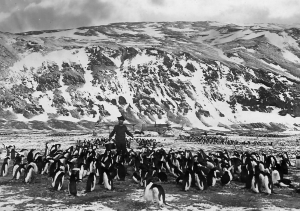Did you know that two Sami men participated in the first overwintering on the Antarctic continent?
The two Sami went along to care for the dogs on an English expedition that overwintered in Antarctica from 1898 to 1900.
 Per Savio has been to fetch water. He is surrounded by Adelie penguins. Photo: Norwegian Polar Institute
Per Savio has been to fetch water. He is surrounded by Adelie penguins. Photo: Norwegian Polar Institute
In 1898 the British vessel Southern Cross set sail for the south. Her destination was Antarctica. The ship carried a Norwegian expedition team led by Carsten Borchgrevink from Kristiania. Two Sami men, Per Savio and Ole Must from Sør-Varanger, were also on the team. They had been hired to tend the dogs. The expedition’s objective was to find the magnetic south pole and, if possible, make an attempt on the geographical pole as well. The expedition was funded privately by the British newspaper magnate George Newnes.
The crossing to Antarctica went smoothly. The Southern Cross anchored in the Bay of Whales in the inner part of the Ross Sea and Borchgrevink’s expedition team spent the winter at Cape Adare in two prefabricated houses they had taken along. This was the first expedition to overwinter on the Antarctic continent. Due to a mishap, the two Sami were the first people to spend an entire night on Antarctica. This happened before the team had found a suitable spot to spend the winter. One day when Per Savio and Ole Must were out with the dogs, the wind picked up and the ship was forced out to open sea to ride out the storm. Savio and Must were left behind on shore with the dogs – but it all turned out well.
The expedition managed to get up on top of the Ross Ice Barrier and went by sled to 78° 50' S, the most southerly longitude that had ever been reached at the time. The team members gathered valuable scientific data and made the first-ever magnetic observations on the continent. And they rediscovered the Bay of Whales, from which Roald Amundsen’s expedition would start 11 years later. The Southern Cross expedition returned to Norway in 1900. Two men died during the journey.